Longnose Gar
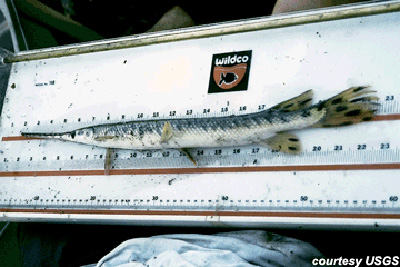
Lepisosteus osseus
These primitive fish are distinctive for their elongated, torpedo-shaped bodies and their overly long snouts which are nearly twice the length of their heads and filled with a row of sharp teeth. They have thick, overlapping scales like armor, and grow to over 6.5 feet long, making them formidable ambush predators in the slow moving rivers, bayous and reservoirs of Eastern United States. They can also gulp air when necessary, allowing them to survive in low oxygen and higher salinity water than most fish.
Order – Lepisosteiformes
Family – Lepisosteidae
Genus – Lepisosteus
Species – osseus
Common Names
The most accepted common name for Lepisosteus osseus in English is longnose gar. Some other common English names are Long-nosed gar, longnose garpike, bonypike, common gar-pike, fish gar, billy gar, billfish, neddlenosed gar, pin nose gar, scissorbill, and scissorlips. Other common names include, pejelagarto (Spanish), gaspar picudo (Spanish), Garpique longnez (French), lepisostee osseuse (French), lauhauki (Finnish), dlinnorylyi pantsirnik (Russian), gemeiner langschnauziger (German), knochenhecht (German), langnasen-knochenhecht (German), kostlin americky (Czech), kostlin dlouhonosy (Czech), kostlin obecny (Czech), langhosad bengadda (Swedish), and langsnudet pansergedde (Danish).
Importance to Humans
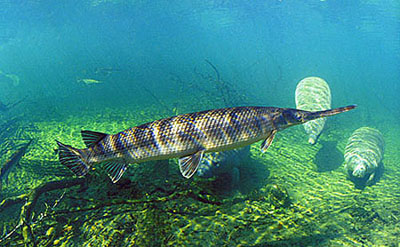
Longnose gar are commercially fished for in Arkansas. They are bowfished and occasionally sportfished locally. In many areas the longnose gar is viewed as a nuisance fish, blamed for eating sportfish. However, the longnose gar is an important apex predator in many ecosystems, and it is important in helping prevent other species from overpopulating habitats.
Danger to Humans
Due to large teeth the longnose gar poses a threat of cuts of laceration, so caution should be taken during handling of this species. The eggs are poisonous to humans and should not be eaten.
Conservation
The longnose gar has been extirpated in some of the peripheral areas of the northern parts of its range. It is common and secure in the interior portions of its range even abundant in many areas.
> Check the status of the longnose gar at the IUCN website.
The IUCN is a global union of states, governmental agencies, and non-governmental organizations in a partnership that assesses the conservation status of species
Geographical Distribution

The longnose gars range extends from Central Florida up the Eastern Seaboard to the St Lawrence River in Quebec. It occurs in all of the Great Lakes accept for Lake Superior. It occurs in the lower Missouri River basin and Mississippi River drainage area. The longnose gar’s range extends south in rivers along the Gulf of Mexico from Florida all the way down into the Rio Grande River basin in Southern Texas and Northern Mexico. The longnose gar enters brackish water occasionally in the Mississippi Sound, Mobile Bay, and Perdido Bay.
Habitat
Longnose gars usually occupy lazy slow moving streams, rivers, reservoirs, bayous, and estuaries. It prefers the sluggish backwater pools to the moving stream. Adults can be found floating near the surface of pools and sluggish streams. The young prefer to hide and hunt in backwaters around submersed vegetation. During mating season though adult longnose gar make short migrations up rivers and reservoirs into small clear quick moving streams in order to spawn and lay eggs.
Biology
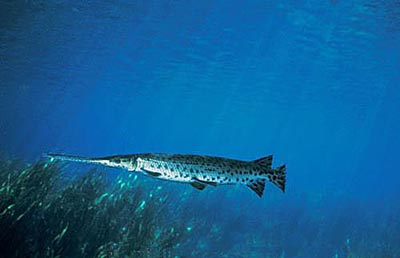
Distinctive Features
Gars can be distinguished from other fish by their long slender tubular bodies. Gars are a primitive group of bony fish that still retain a spiral valve intestine, which is a primitive feature of the digestive system commonly associated with elasmobranchs. Gars bodies are covered with rhomboidal ganoid scales, which are composed of two layers. The outer layer is of ganoin and the inner layer is made of isopedine, both layers are penetrated by blood vessels. These scales interlock to produce a virtual suit of armor leaving the gars with few natural predators. Gars also have a highly vascularized swim bladder connected to the pharynx by a pneumatic duct. This enables them to gulp air, which aids in facultative air breathing. This allows gar to breathe when there are very low oxygen levels in the water. The longnose gars can be distinguished from any other gar by its elongate snout more than twice the length of the rest of their head. The longnose gar can be distinguished from the alligator gar because it has only 1 row of sharp, villiform teeth in the upper jaw.
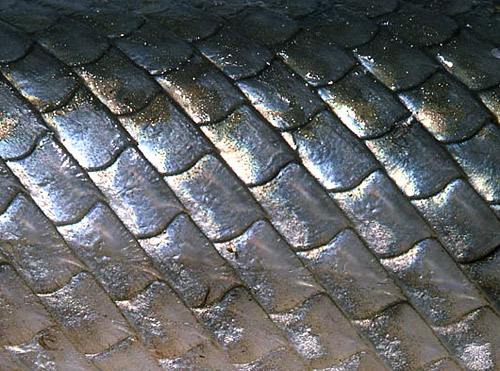
Coloration
The longnose gar is olivaceous brown to green dorsally fading to pale yellow or white ventrally. Color of specimen is dependent on the clarity of the water it is in. Longnose gar in clear water have a much deeper green color than those in murky water which will be more brown and drab. The longnose gar has spots on its dorsal anal and caudal fins. It also has spots on the dorsum of the body that do not extend onto the head. The margins of the scales and the spaces in between the scales are black. The young have a black stripe along the sides and are brown dorsally and white ventrally.
Dentition
The longnose gar has an elongate snout with a single row of long sharp villiform teeth. These teeth and long snout enable the gar to thrash its head to capture and hold prey.
Size, Age & Growth
Gars are slow growing fishes that are relatively long lived. Newly hatched gars are 8 to 10 mm in length. Hatchlings attach themselves to vertically to submerged objects by an adhesive disc on their snout. Young remain attached by the adhesive disc until the yolk sac is absorbed (about 9 days). After the absorption of the yolk sac the young are able to remain horizontal, take their first aerial breath and begin feeding. Female gars get larger and live longer than male gars do. It takes female gars 6 years to reach sexual maturity and they can live up to 22 years old. Male gars mature at 3 to 4 years of age and rarely live longer than 11 years. Longnose gar can reach sizes up to 6 ft 8 in (2 m) and 35 lbs. (16 kg).
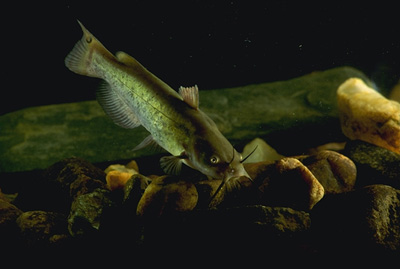
Food Habits
Young longnose gar start feeding after about 10 to 11 days after hatching. Young gars begin feeding on small crustaceans such as copepods, and insects. They quickly switch over to a diet of primarily fish. In Lake Texoma (Oklahoma), the young longnose gar diet consisted of over 80% inland silversides (Menidia beryllina) and less than one percent game fish. As adults longnose gar are primarily piscivores eating a variety of fish species, with their primary food species changing from area to area. Primary food fishes in many inland areas include sunfishes of the family Centrarchidae, and shiners of the family Cyprinidae. In Florida longnose gars feed primarily on gizzard shad (Dorosoma cepedianum), and bullhead catfish. In coastal areas, longnose gars consume large numbers of menhaden.
Long nose gars are ambush predators laying in wait or slowly stalking their prey. Longnose gars are primarily surface oriented feeders. The gars feed both day and night but are more active as night feeders. Gars attack their prey from the side. The wait until the prey is in range then lunge and thrash their head from side to side, impaling their prey on their long needle sharp teeth. They then maneuver the prey in order to swallow it head first.
Reproduction
Reproduction takes place during the spring, from April to August depending on geographic region. Longnose gars migrate up into small, clear, faster moving streams in order to mate. Spawning occurs over gravel or weedy areas. During spawning longnose gar congregate together in small streams. One female is usually accompanied by 2 to 4 males, which swim along side at irregular intervals. Eggs are demersal and adhesive, they sink to the bottom after being released from the female and fertilized and attach to the substrate. The eggs hatch in 3-9 days depending upon water temperature.
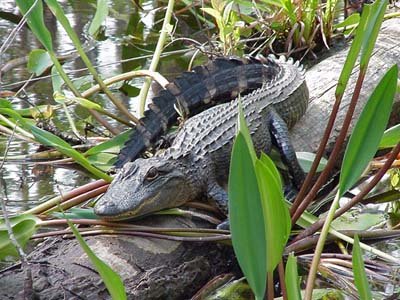
Predators
Larger fish predate young longnose gars. Due to larger size and ganoid scaling the adult longnose gar has very few predators. In southern regions of the longnose gars range it is preyed upon by the American Alligator (Alligator mississippiensis).
Taxonomy
Linnaeus first described the longnose gar in 1758. The type locality was in Virginia. Linnaeus gave the longnose gar the name Esox osseus. The genus was later changed from Esox, which is the genus for pike, to Lepisosteus, which is the genus of the slender gars. The current accepted scientific name for the longnose gar is Lepisosteus osseus (Linnaeus, 1758). The name lepisosteus comes from a combination of the two words lepis the greek word for “scale”, and osteos which is Latin for “bony”. This name is used to describe gars extremely hard ganoid scales. The specific epithet osseus is also Latin for the word “bony”.
Prepared by: Nathaniel Goddard